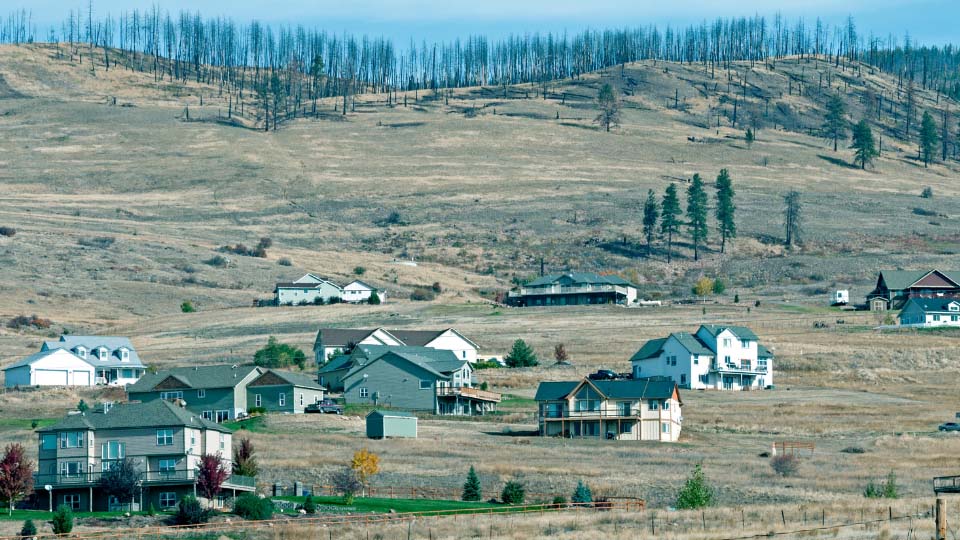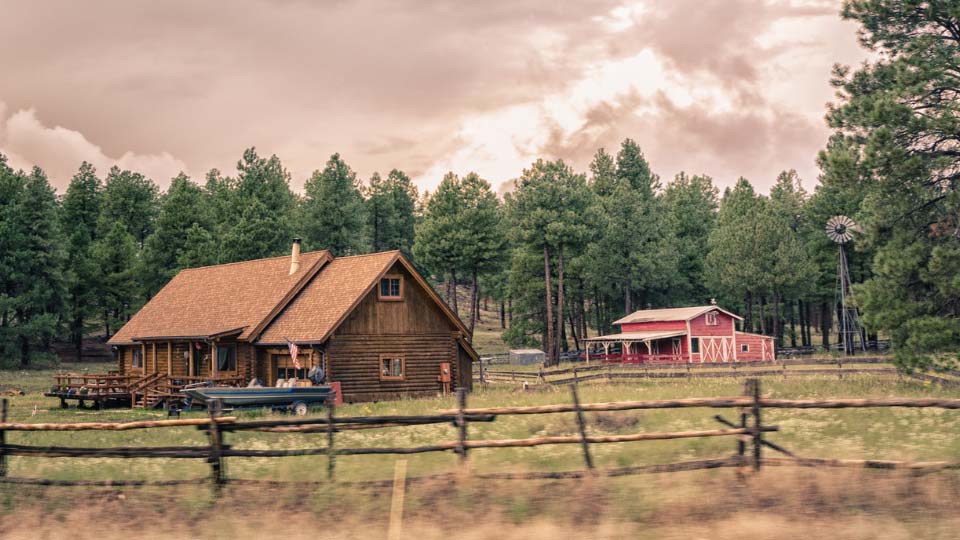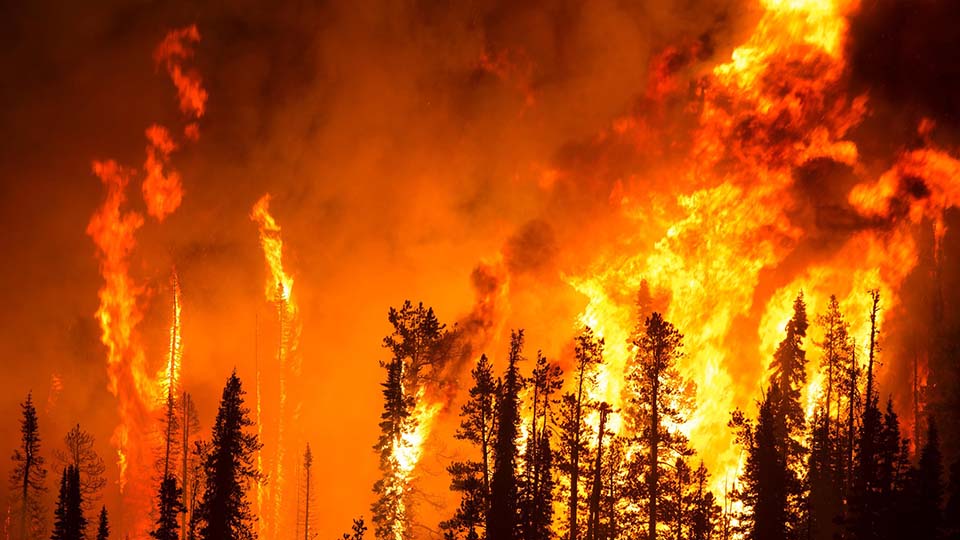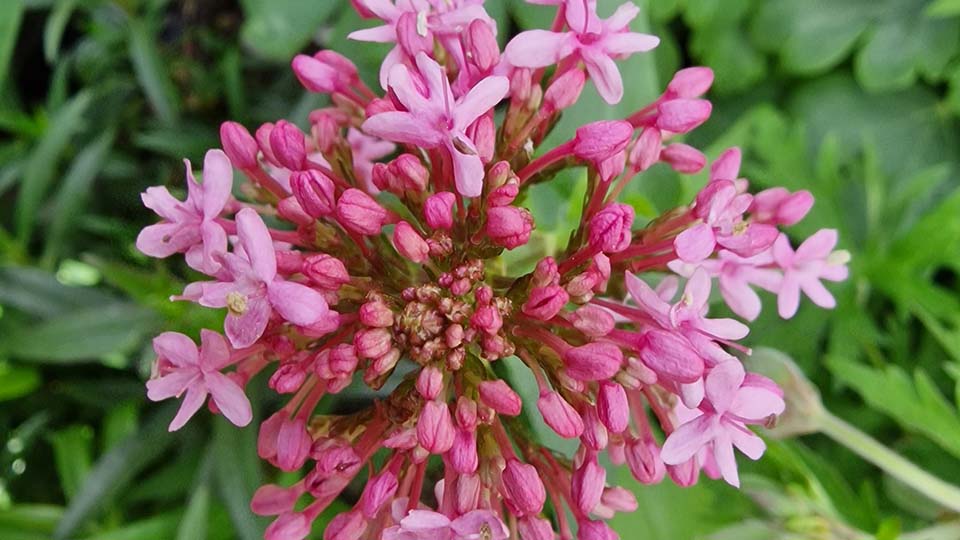Firewise Plants for Utah Landscapes

Wildland/Urban Interface Fire Hazards
Fire is an important part of many of Utah’s natural landscapes, including landscapes in fringe or interface areas near rapidly growing cities, towns, and recreational developments. But when people build homes in these areas, a minor fire that might have burned a few trees and shrubs in a natural area instead can become a major disaster. Throughout Utah wildland/urban interface fires are becoming more of a problem as people choose to live in previously undeveloped areas on the edges of cities, areas with trees, shrubs, and grasses that often are very flammable.
Firewise Landscaping
Firewise landscaping is the practice of designing, installing, and maintaining a landscape to minimize fire hazard to structures, residents, and neighbors, while maintaining components of the native ecosystems that attracted people to live in such areas in the first place. Such landscaping uses appropriate plants, then places and maintains them so that fuel loads decrease in zones between an area to be protected (like your home) and the surrounding wildland.
Use of firewise plants alone does not guarantee fire safety for you or your home. But, firewise plants coupled with good design and maintenance help establish a defensible space around your home or neighborhood that assists firefighters in their protection efforts. Native vegetation around homes and neighborhoods also can be managed in a firewise manner through pruning, thinning, and occasional clearing.
Firewise Plant Characteristics
Firewise plants have a number of characteristics in common, but also can vary considerably. Following are some important points about these plants and their management.
- No plant is fireproof. All will burn in a very intense fire.
- Firewise plants all have one or more of these firewise characteristics:
- Tissues contain more moisture, especially during the fire season.
- Tissues contain low amounts of volatile oils and other readily flammable chemicals.
- Plants provide less fuel, either by producing less litter or by staying small.
- Plants are compact or low to the ground, allowing them to be used in the landscape to interrupt fire pathways.
- All trees provide large amounts of fuel to a fire, so they should be carefully placed and maintained. Broadleaved trees generally are less flammable than conifers (pines, firs, spruces, junipers).
- Most of the firewise plants listed in this publication do well in open, sunny areas typical of most fire-prone sites.
- Some firewise plants need minimal or no irrigation to remain green and healthy; over-irrigation may harm such plants or may cause them to grow too fast and become hazardous. Other plants will need supplemental water to survive. Know your plants’ needs and habits so you can use and manage them appropriately.
- When choosing a particular plant species or cultivar for a firewise planting, favor those that are low to the ground, compact, and that stay green and healthy with low maintenance and minimal water.
- All firewise plants should receive periodic maintenance, including removal of dead leaf and stem material within the crown and on the ground, pruning to keep crowns thinner and to keep tree crowns high, and removal of individual plants to break up fuel continuity.
- Make sure that the plants you are considering are cold-hardy (check the USDA hardiness zone for the plant and compare it to the zone for your area) and otherwise well-suited for your locale and the specific planting site.
- Some plants are weedy and may even be illegal to plant or cultivate.
Firewise Plants for Utah Landscapes
The following table lists plants and groups of plants that can be firewise if used properly in the landscape and properly maintained. Plants or groups of plants marked with an * can become weedy in certain circumstances, and may even be noxious weeds with legal restrictions against their planting and cultivation. Check with your local Extension office or State Department of Agriculture office for information on noxious weeds in your area.
Most of these plants are fairly commonly available in the nursery trade, and cultivars and hybrids usually are available. All of these plants should be cold-hardy in most of Utah (USDA hardiness zones 4 or 5). Some need considerable supplemental irrigation, while others need very little water. Be sure to learn about the plants you use and know their requirements.
Where no particular species or cultivar is listed, or when considering plants not listed here, pick one that has firewise characteristics as described above. Don’t assume that a plant is firewise just because it is closely related to one in the list or because it has a similar name.
Grasses
| Scientific Name | Common Name | Notes |
|---|---|---|
| Agropyron cristatum | Crested Wheatgrass | resists fire spread due to growth form |
| Buchloe dactyloides | Buffalograss | low growing without mowing; moist through summer with minimal irrigation |
| Dactylis glomerata | Orchardgrass | must be mowed or grazed |
| Festuca cinerea | Blue Fescue | most low growing; may need to mow; stays moist with irrigation |
| Lolium species | Rye Grass | stays green with less irrigation than some; need to mow or graze |
| Pascopyrum smithii | Western Wheatgrass | low fuel loads; regrows quickly after fire |
| Poa pratensis | Kentucky Bluegrass | low growing; may need to mow; stays moist with irrigation |
| Poa secunda | Sandberg Bluegrass | low growing without mowing; low fuel loads |
Herbaceous Perennials
| Scientific Name | Common Name | Notes |
|---|---|---|
| Achillea clavennae | Silvery Yarrow | small plants for dry sites |
| Achillea filipendulina | Fernleaf Yarrow | large; likes dry sites; moist in summer |
| Achillea—other species & hybrids | Yarrow* | some are volatile; good for dry sites |
| Aquilegia species & hybrids | Columbine | likes moisture and some shade |
| Armeria maritima | Sea Pink, Sea Thrift | low growing; dry, infertile sites only; salt tolerant |
| Artemisia stelleriana | Beach Wormwood, Dusty Miller | needs very well-drained soil; moist in summer |
| Artemisia—other species & hybrids | Various names* | some are volatile; all like dry soils |
| Bergenia species & hybrids | Bergenia | moisture loving; medium-sized; semi-evergreen |
| Centranthus ruber | Red Valerian, Jupiter’s Beard | gets fairly large; moist in summer |
| Cerastium tomentosum | Snow-in-summer | low growing; moist in summer |
| Coreopsis auriculata var. Nana | Dwarf Mouse Ear Coreopsis | needs moisture; fairly low growing |
| Coreopsis—other perennial species | Coreopsis | more drought tolerant; larger plants |
| Delosperma nubigenum | Hardy Ice Plant | also other ice plants; very drought tolerant; low growing |
| Dianthus plumarius & others | Pinks | use perennials; needs moisture; moist in summer |
| Erigeron hybrids | Fleabane | moist through summer |
| Gaillardia x grandiflora | Blanketflower | drought, heat tolerant; moist in summer; large |
| Geranium cinereum | Hardy Geranium | low growing; cool sites |
| Geranium sanguineum | Bloody Cranesbill, Bloodred Geranium | low/medium growing; partial shade or sun |
| Geranium species | Geranium | use perennials; most low growing; need shade where hot |
| Hemerocallis species | Coral Bells, Alum Root | fairly low growing; evergreen |
| Iberis sempervirens | Evergreen Candytuft | also other species, hybrids; low growing foliage |
| Iris species & hybrids | Iris | green and moist through summer |
| Kniphofia species & hybrids | Kniphofia species & hybrids | Kniphofia species & hybrids |
| Lavandula species | Lavendar | moist in summer; compact; cut to ground regularly |
| Leucanthemum x superbum | Shasta Daisy | Shasta Daisy |
| Limonium latifolium | Limonium latifolium | Limonium latifolium |
| Limonium latifolium | Flax | good for tough sites & soils |
| Liriope spicatum | Lily-turf | fairly low growing; moist or dry sites; evergreen |
| Lupinus species & hybrids | Lupine* | some are annuals; poisonous to livestock; good for poor soils |
| Medicago sativa | Medicago sativa | green & moist through summer; low growing |
| Oenothera species | Primrose | fairly low growing; best on poor soils |
| Papaver species | Poppy | easy to grow; cut back regularly |
| Penstemon species & hybrids | Penstemon | use on well-drained soils |
| Perovskia atriplicifolia | Russian Sage, Azure Sage | moist through summer; cut back yearly |
| Potentilla nepalensis | Nepal Cinquefoil | prostrate form |
| Potentilla neumanniana ‘Nana’ (P. verna) | Spring Cinquefoil, Creeping Potentilla | very low growing |
| Potentilla—other non-shrubby species & hybrids | Cinquefoil, Potentilla* | sulfur cinquefoil is weedy; full sun; moist through summer |
| Salvia species & hybrids | Salvia, Sage* | some are annuals; Mediterranean sage is weedy; only use low growing, small plants |
| Sedum species | Stonecrop, Sedum | very low growing; fleshy, moist leaves; drought tolerant |
| Sempervivum tectorum | Hen and Chicks | very low growing; succulent; good on droughty, poor soils |
| Sibbaldiopsis (Potentilla) tridentata | Wineleaf Cinquefoil | prostrate, spreading form |
| Stachys byzantina | Lamb’s Ear | moist through summer; good on poor soils |
| Yucca filamentosa | Yucca | evergreen; very drought tolerant |
Shrubs and Woody Vines
| Scientific Name | Common Name | Notes |
|---|---|---|
| Arctostaphylos uva-ursi | Bearberry, Kinnikinnick, Manzanita | very low and spreading; evergreen; use on poor soils; needs little pruning; salt tolerant |
| Atriplex species | Saltbush | very drought tolerant; low maintenance |
| Ceanothus americanus | New Jersey Tea | low, dense form; evergreen; fairly trouble free; drought tolerant |
| Ceanothus ovatus (C. herbaceous) & others | Ceanothus | fairly low growing; evergreen; low maintenance |
| Cistus species | Rock-rose | not all are cold hardy; evergreen; dry sites; size varies |
| Cotoneaster dammeri | Bearberry Cotoneaster | low growing; evergreen; minimal maintenance; dry sites |
| Cotoneaster horizontalis | Rockspray or Rock Cotoneaster | very low and spreading; evergreen |
| Cotoneaster—other compact species | Cotoneaster | low growth form; low maintenance; tough |
| Hedera helix | English Ivy | evergreen vine; low growing, spreading, climbing; prune to control spread; sun or shade |
| Kochia prostrata | Immigrant Forage Kochia | stays green; no volatiles; clumps break up fuel continuity; don’t use weedy annual kochia |
| Lonicera species & hybrids | Honeysuckle | shrubs or vines; use low growing species, cultivars |
| Mahonia repens | Creeping Oregon Grape | very low growing, spreading shrub; evergreen; needs some shade |
| Parthenocissus quinquefolia | Virginia Creeper | vine; tough and vary adaptable; prune to control spread |
| Prunus besseyi (P. pumila var. besseyi) | Western Sandcherry | small, spreading shrub for dry, tough sites |
| Purshia tridentata | Bitterbrush, Antelope Bitterbrush | low maintenance; good for tough, dry sites |
| Pyracantha species | Firethorn, Pyracantha | evergreen shrub; use low growing selections; prune regularly |
| Rhamnus species | Buckthorn | tough shrub; low maintenance |
| Rhus trilobata | Skunkbush Sumac | easy to grow shrub; fairly small; low maintenance |
| Rhus—other species | Sumac | fairly tough and drought tolerant; some get large; thin or prune periodically |
| Ribes species | Currant, Gooseberry | use low growing dwarf forms; fairly tough, adaptable |
| Rosa rugosa & other hedge roses | Rugosa Rose | medium shrub; tough, fairly drought and salt tolerant |
| Shepherdia canadensis | Russet Buffaloberry | does well on very poor soils; drought tolerant; fixes nitrogen; salt tolerant |
| Syringa vulgaris | Lilac | small to large shrubs; stays green through summer with irrigation; thin and prune regularly |
| Vinca major | Large Periwinkle | low growing, prostrate groundcover; sun or shade |
| Vinca minor | Dwarf Periwinkle, Common Periwinkle | similar to large periwinkle, but very low to the ground |
Trees
| Scientific Name | Common Name | Notes |
|---|---|---|
| Acer species | Maple | needs supplemental moisture |
| Betula species | Birch | needs supplemental moisture; use borer resistantselections |
| Cercis occidentalis (C. orbiculata) | California Redbud | small tree or shrub; drought and heat resistant |
| Populus tremuloides | Quaking Aspen | needs supplemental moisture; good if maintained in young clumps, otherwise not suitable for valleys |
| Populus—other species | Poplar, Cottonwood | needs supplemental moisture; most need plenty of space |
| Salix species | Willow | needs supplemental moisture; disease prone; some good shrubs |
For More Information
- Kuhns, Michael 1998. Trees of Utah and the Intermountain West. USU Press, Logan, UT 84322-7800. 341pp.
- Still, Steven M. 1994. Manual of Herbaceous Ornamental Plants. Stipes Publ., 10-12 Chester St., Champaign, IL 61820. 814 pp.
- Visit the Forestry Extension Web site at http://extension.usu.edu/forestry/ for fire safety information. Also, go to www.firewise.org and www.utahfireinfo.gov for more fire-related information.
May 2012
Utah State University Extension
Peer-reviewed fact sheet
Authors
Mike Kuhns, State Extension Forester
Related








